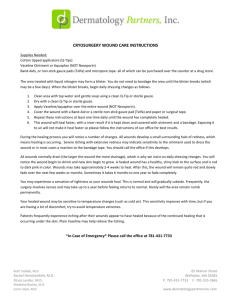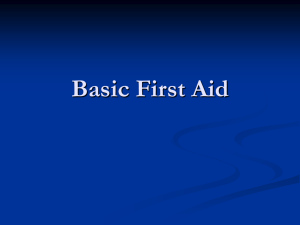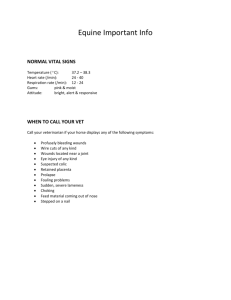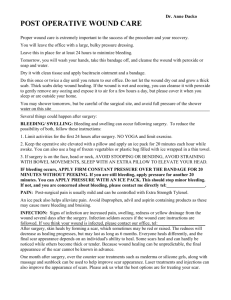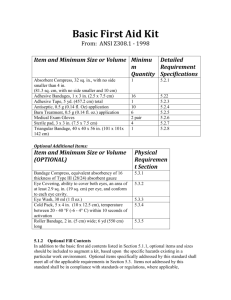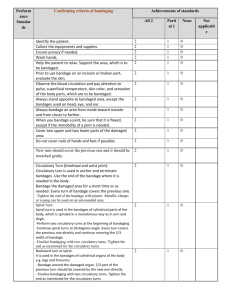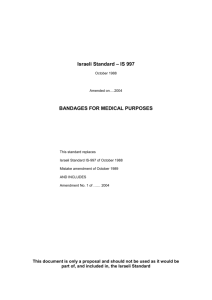Bandaging Techniques for Emergencies Sarah J. Waxman, DVM
advertisement
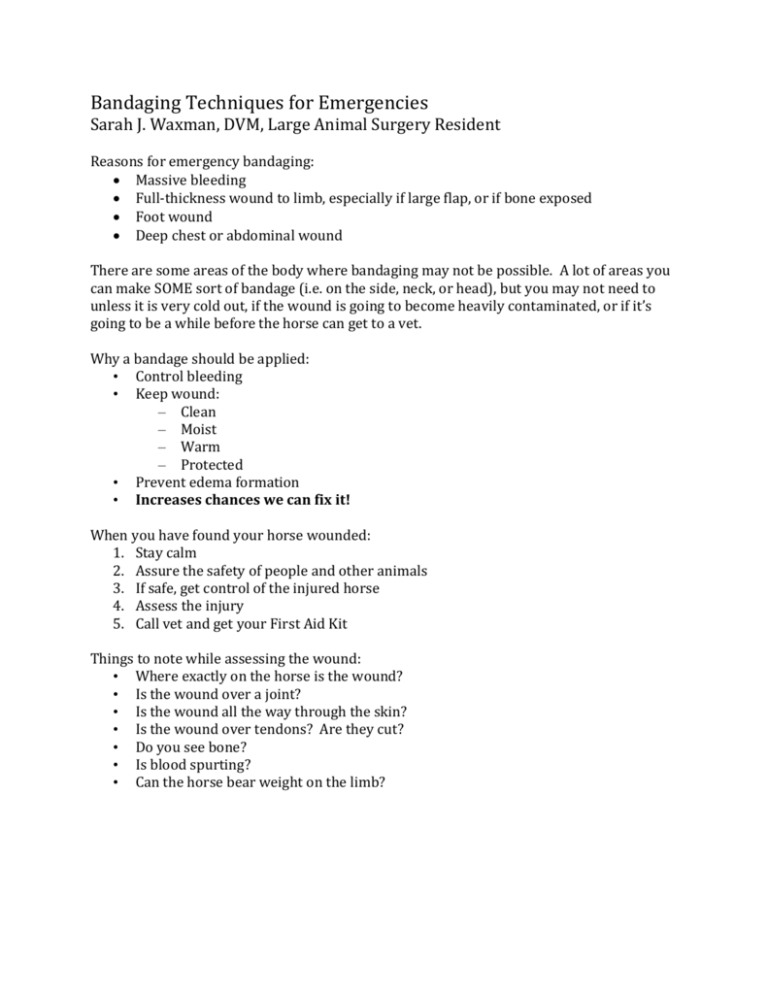
Bandaging Techniques for Emergencies Sarah J. Waxman, DVM, Large Animal Surgery Resident Reasons for emergency bandaging: Massive bleeding Full-thickness wound to limb, especially if large flap, or if bone exposed Foot wound Deep chest or abdominal wound There are some areas of the body where bandaging may not be possible. A lot of areas you can make SOME sort of bandage (i.e. on the side, neck, or head), but you may not need to unless it is very cold out, if the wound is going to become heavily contaminated, or if it’s going to be a while before the horse can get to a vet. Why a bandage should be applied: • Control bleeding • Keep wound: – Clean – Moist – Warm – Protected • Prevent edema formation • Increases chances we can fix it! When you have found your horse wounded: 1. Stay calm 2. Assure the safety of people and other animals 3. If safe, get control of the injured horse 4. Assess the injury 5. Call vet and get your First Aid Kit Things to note while assessing the wound: • Where exactly on the horse is the wound? • Is the wound over a joint? • Is the wound all the way through the skin? • Is the wound over tendons? Are they cut? • Do you see bone? • Is blood spurting? • Can the horse bear weight on the limb? **It is important to be able to tell your vet these things so they can advise you how to manage the horse while they are on their way or so that you can make the horse road ready if you are hauling to them. If there is a LOT of bleeding, look quickly at the wound so you can give them at least a little bit of information and/or snap a quick photo with your Smart Phone. Then get to work on a bandage to control the bleeding. If massive bleeding isn’t a problem then you can proceed with a standard wound bandage. Even if the injury requires further stabilization such as a splint, all bandages pretty much start at the same place. Discuss with your veterinarian what else might be necessary for the specific situation. Cleanliness • Wear exam gloves • For lower limb wound, if possible, take horse to concrete area or mat or lay down towel on ground • If the wound is grossly contaminated, clean with saline soaked gauze or hose • Carefully dry surrounding hair Necessary materials for a proper bandage: • Exam gloves • Non-stick pad(s)** • Conforming gauze roll** • Cotton leg wrap** • Brown gauze roll • Vetwrap** • Elasticon **Most important parts for emergency bandage To apply proper bandage: Apply non-stick pad to wound Secure pad with conform gauze; make snug but not tight Apply cotton leg wrap snugly to leg Apply brown gauze over cotton, leaving ½ inch of cotton exposed at top and bottom; make snugly enough that cotton is compressed Apply vetwrap, leaving ½ inch of cotton exposed at top and bottom; pull TIGHT enough that little squares pattern stretches out Apply Elasticon to top and bottom of bandage; apply without tension onto skin and then overlap onto bandage Massive hemorrhage (a.k.a. a lot of bleeding) • If possible, apply non-stick pad and conform gauze roll • OR just apply the cotton leg wrap followed by brown gauze and/or vetwrap - TIGHT • Still bleeding? • Apply more cotton and vetwrap • Repeat • Other materials: • Reusable standing wraps • Towels • More pressure! (duct tape, white tape) • Clothing items Important points Set bandage where wound is o May need to set bandage at ground to cover heels or coronary band o May require full limb bandage Front limb bandage Cone-shaped Accessory carpal bone is pressure point o Figure-8 conform to try to prevent bandage sores o Cut “release” through outer layers Hind limb bandage Cone-shaped limb Calcaneous (point of hock) is pressure point o Figure-8 conform to try to prevent bandage sores o Cut “release” through outer layers Doesn’t actually matter which way you wrap bandage around leg as long as all material is going same direction Foot Bandage • Apply non-stick pad and conform gauze • Apply vetwrap around hoof and over heels • Cut release at coronary band if necessary • Apply duct tape “boot” (make a square of 2-3 layers of overlapping strips) • Cut in corners for easy conforming • Apply Elasticon to top Chest Wounds • Place an occlusive material over the wound – Saran wrap – Plastic bag • Tape in place with Elasticon or other tape all the way around the chest Abdominal Wounds • Pack area with sterile gauze – Count sponges! – Clean towel, etc • Hold in place with Elasticon or tape all the way around abdomen Bandaging No No’s • NO vetwrap directly on the skin • Do NOT make Elasticon tight on skin • Don’t make other parts of bandage too loose (opposite of small animal limb bandages) • Don’t check to see if bleeding has stopped • NO out of sight out of mind… if in doubt, call your vet!

